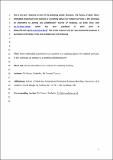Files in this item
Resin-embedded anatomical cross-sections as a teaching adjunct for medical curricula : is this technique an alternative to potting and plastination?
Item metadata
| dc.contributor.author | Chisholm, Fraser | |
| dc.contributor.author | Varsou, Ourania | |
| dc.date.accessioned | 2019-04-15T23:38:50Z | |
| dc.date.available | 2019-04-15T23:38:50Z | |
| dc.date.issued | 2018-07 | |
| dc.identifier | 252770949 | |
| dc.identifier | 0d569361-cee9-4320-8d45-a547d1c48cf7 | |
| dc.identifier | 85045750534 | |
| dc.identifier | 000434275300009 | |
| dc.identifier.citation | Chisholm , F & Varsou , O 2018 , ' Resin-embedded anatomical cross-sections as a teaching adjunct for medical curricula : is this technique an alternative to potting and plastination? ' , Journal of Anatomy , vol. 233 , no. 1 , pp. 98-105 . https://doi.org/10.1111/joa.12816 | en |
| dc.identifier.issn | 0021-8782 | |
| dc.identifier.other | ORCID: /0000-0003-3069-4130/work/43873430 | |
| dc.identifier.uri | https://hdl.handle.net/10023/17528 | |
| dc.description.abstract | With an ever expanding use of cross-sectional imaging for diagnostic and therapeutic purposes, there has also been an increase in the need for exposure to such radiological and anatomical views at the undergraduate and postgraduate level to allow for early familiarisation with the relevant anatomy. Cadaveric cross-sections offer an excellent link between the two-dimensional radiological images and the three-dimensional anatomical structures. For such cross-sections to be useful and informative within educational settings, they need to be: i) safe for students and trainees to handle; ii) robust enough to withstand repeated handling; and iii) display anatomy clearly and accurately. There are various ways in which cross-sections can be prepared and presented; plastinated, potted, vacuum sealed or unmounted. Each of these approaches have advantages and disadvantages in terms of technical complexity, cost and quality. As an alternative to the above methods and their limitations, we propose the presentation of cadaveric cross-sections in a transparent polyester resin. This technique has been used extensively in craft and artistic industries, yet it is not publicised in anatomy teaching settings. The sections were layered in polyester resin contained within a mould. The set resin required finishing by sanding and polishing. The final cross-sections were safe to handle, durable and maintained excellent anatomical relationships of the contained structures. The transparency of the set resin was water-clear and did not obstruct the visibility of the anatomy. The cost of the process was found to be significantly lower, requiring less infrastructure when compared to alternative methods. The following trivial technical difficulties were noted during the resin-embedding process: trapped air causing organs to float; retained water in the anatomical specimens creating bubbles and discolouration; and microbubbles emerging from the solution affecting the finished surface. However, solutions to these minor limitations have been discussed within the paper with the aim of future proofing this technique. The sections have been used in undergraduate medical teaching for four years and they have shown no signs of degradation or discolouration. We believe that this method is a viable and cost effective alternative to other approaches of displaying cross-sectional cadaveric material and will help students and trainees bridge the gap between the traditional three-dimensional anatomy and two-dimensional images. | |
| dc.format.extent | 8 | |
| dc.format.extent | 1374628 | |
| dc.language.iso | eng | |
| dc.relation.ispartof | Journal of Anatomy | en |
| dc.subject | Anatomy | en |
| dc.subject | Cross-sections | en |
| dc.subject | Plastination | en |
| dc.subject | Potting | en |
| dc.subject | Resin-embedding | en |
| dc.subject | Teaching | en |
| dc.subject | L Education (General) | en |
| dc.subject | QM Human anatomy | en |
| dc.subject | Anatomy | en |
| dc.subject | T-NDAS | en |
| dc.subject.lcc | L1 | en |
| dc.subject.lcc | QM | en |
| dc.title | Resin-embedded anatomical cross-sections as a teaching adjunct for medical curricula : is this technique an alternative to potting and plastination? | en |
| dc.type | Journal article | en |
| dc.contributor.institution | University of St Andrews. School of Medicine | en |
| dc.contributor.institution | University of St Andrews. Education Division | en |
| dc.identifier.doi | 10.1111/joa.12816 | |
| dc.description.status | Peer reviewed | en |
| dc.date.embargoedUntil | 2019-04-16 |
This item appears in the following Collection(s)
Items in the St Andrews Research Repository are protected by copyright, with all rights reserved, unless otherwise indicated.

